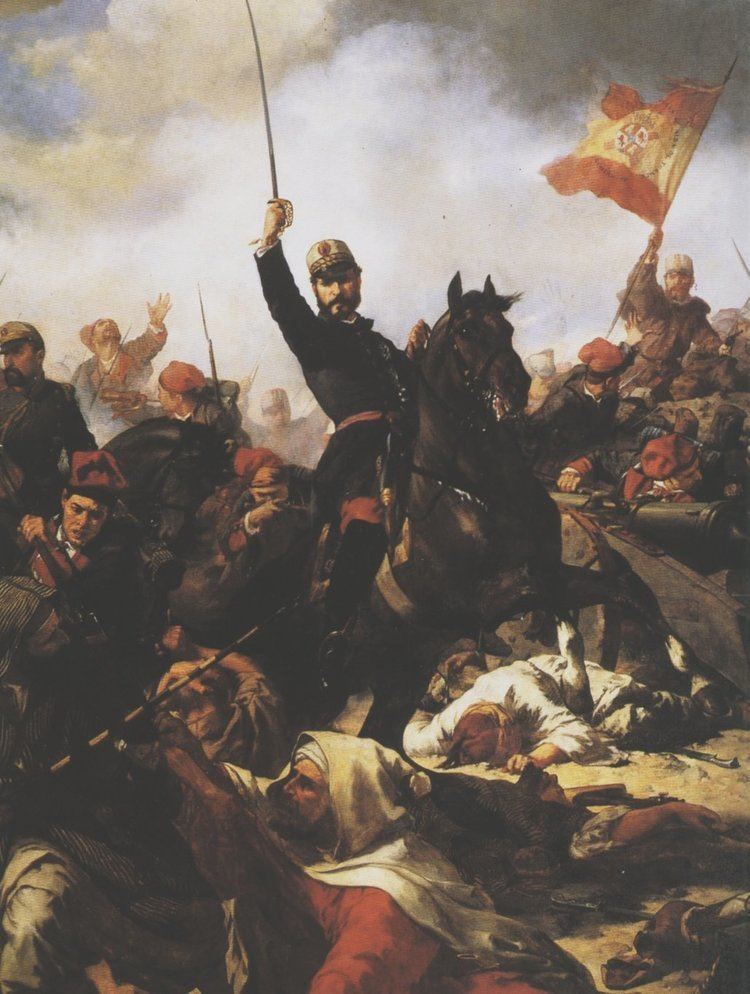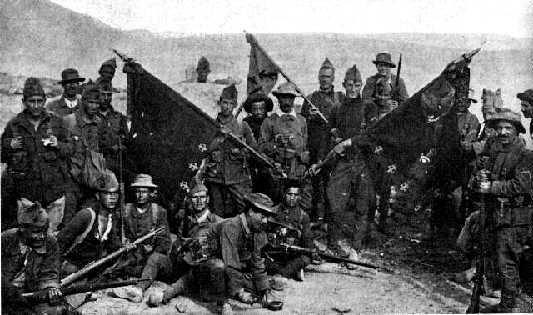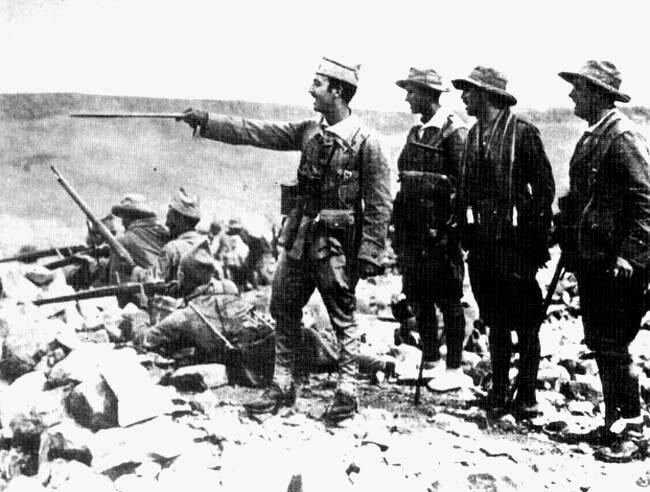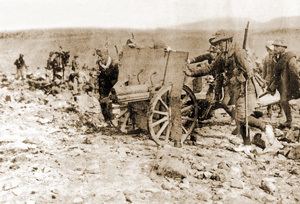Date 1920 | ||
 | ||
Similar Battle of Annual, Hispano‑Moroccan War, Alhucemas landing, Ifni War, Spanish Civil War | ||
What if call of duty the rif war of 1921 1926
The Rif War, also called the Second Moroccan War, was fought in the early 1920s between the colonial power Spain (later joined by France) and the Berbers of the Rif mountainous region. Led by Abd al-Karim, the Riffians at first inflicted several defeats on the Spanish forces by using guerrilla tactics and captured European weapons. After France's entry into the conflict and the major landing of Spanish troops at Al Hoceima, considered the first amphibious landing in history to involve the use of tanks and aircraft, Abd el-Karim surrendered to the French and was taken into exile.
Contents
- What if call of duty the rif war of 1921 1926
- Origins
- Rifian forces
- Spanish forces
- Early stages
- French intervention
- Outcome
- References

Origins

During the early 20th century, Morocco had fallen into the French and Spanish spheres of influence, becoming divided into protectorates ruled by the two European nations. The Rif region had been assigned to Spain, but given that even the Sultans of Morocco had been unable to exert control over the region, Spanish sovereignty over the Rif was strictly theoretical. For centuries, the Berber tribes of the Rif had fought off any attempt to impose outside control on them. Though nominally Muslim, the tribes of the Rif had continued many pagan practices such as worshipping water spirits and forest spirits that were contrary to Islam. Attempts by the Moroccan sultans to impose orthodox Islam on the Rif had been successfully resisted by the tribesmen.

For centuries Europeans had seen the Rif mountains and the outlines of people on the mountains from ships in the Mediterranean Sea, but almost no European had ever ventured into the mountains. Walter Burton Harris, the Morocco correspondent for The Times, who covered the war wrote that as late as 1912 only "one or two Europeans had been able to visit the cedar forests that lie south of Fez. A few had traveled in the southern Atlas and pushed on into the Sus...and that was almost all". The reason for, as Harris wrote, was the Berbers "were often as inhospitable to the Arab as they were to the foreigner", and generally killed any outsiders who ventured into their territory.

Vincent Sheean, who covered the war for The New York Times, wrote that the Rif was a truly beautiful countryside of "Crimson mountains flung against a sky of hieratic blue, gorges magnificent and terrifying, peaceful green valleys between protecting precipices", a place that reminded him of his native Colorado. The Rif was also rich in high-grade iron, which could be easily extracted via open pit mining. The Spanish state could collect much money in the form of taxes and royalties from the iron mining, which made the Spanish state anxious to bring the Rif under its control. The concession to mine iron in the Rif had been granted to the millionaire Don Horacio Echevarrieta who by 1920 had brought out 800, 000 tons of high grade iron which as it had been extracted via open pit mining was cheaply attained and fetched the highest prices. The iron mining caused much environmental damage and required the displacement of the Riffans, who of course received no share of the profits, and thus understandably were opposed to the iron mines being developed on their land. When King Alfonso XIII of Spain ascended to the throne in 1886, Spain could at least make the pretense of being a world power, having colonies in the Americans, Africa, Asia and the Pacific. In the Spanish-American War of 1898, Spain lost Cuba, Puerto Rico, and the Philippines, and in 1899 sold the Mariana and Caroline islands to Germany, leaving Spain only with some footholds on the Moroccan coast and Spanish Guinea. To compensate for the lost empire in the Americas and Asia, there emerged a powerful africanista faction in Spain led by Alfonso, who wanted a new empire in Africa. Finally, the Roman Catholic Church was politically powerful in Spain, and much of the Spanish clergy preached the need for new crusade to continue the Reconquista by conquering Morocco, thus adding their voices to the africanista choir. For all these reasons, Spain had been pushing into the Rif since 1909.
Rifian forces

The Berber tribesmen had a long tradition of fierce fighting skills, combined with high standards of fieldcraft and marksmanship. They were capably led by Muhammad Ibn 'Abd al-Karim al-Khattabi, commonly called Abd el-Krim, who showed both military and political expertise. However, the Rifian regular army was never a very large force. The elite of the Rifian forces formed regular units which according to Abd el-Krim, quoted by the Spanish General Manuel Goded, numbered 6,000 to 7,000. Other sources put it much lower, at around 2,000 to 3,000.

The remaining Rifians were tribal militia selected by their Caids and not liable to serve away from their homes and farms for more than 15 consecutive days. General Goded estimated that at their peak, in June 1924, the Rifian forces numbered about 80,000 men, although Abd el-Krim was never able to arm more than 20,000 men at a time. However, this force was largely adequate in the early stages of the war. In the final days of the war Rifian forces numbered about 12,000 men. In addition Rifian forces were not well armed, with weapons badly maintained and in poor condition.
Spanish forces
Initially, the Spanish forces in Morocco were largely composed of conscripts and reservists from Spain itself. These "Peninsular" troops were poorly supplied and prepared, few had marksmanship skills and proper battle training, and widespread corruption was reported amongst the officer corps, reducing supplies and morale. Even with their numerical superiority, they proved no match for the highly skilled and motivated Rifian forces. Accordingly, much reliance came to be placed on the mainly professional units comprising Spain's Army of Africa. Since 1911, these had included regiments of Moroccan Regulares, who proved to be excellent soldiers. In 1909, during an earlier war with the Rif tribesmen, an attempt by the Spanish government to call up reservists had led to a working class uprising in Barcelona known as Tragic Week as the Catalan trade unions, many led by anarchists argued that the working class of Barcelona had no quarrel with the people of the Rif. After the Tragic Week of 1909, the Spanish government starting in 1911 tried to raise as many Regulare units as possible to avoid further working class resistance to colonial wars as much of the Spanish working class had no desire to see their sons sent to Morocco, beginning a policy of what the Spanish historian Jose Alvarez called "Moroccanizing" the conquest of the Rif. Following the difficulties and setbacks that it had experienced in 1909-11, the Spanish army began to adopt much in organization and tactics from the French North African forces garrisoning most of Morocco and neighboring Algeria. Particular attention was paid to the French Foreign Legion and a Spanish equivalent, the Tercio de Extranjeros ("Foreigners brigade"), known in English as the "Spanish Legion", was formed in 1920. The regiment's second commander was then-Col. Francisco Franco, having risen rapidly through the ranks. In the Rif war, it was the Regulares and the Spanish Foreign Legion founded in 1919 that provided the elite forces that won Spain the war.
Less than 25% of this "Foreign Legion" were, in fact, non-Spanish. Harshly disciplined and driven, they quickly acquired a reputation for ruthlessness. As their number grew, the Spanish Legion and the Regulares increasingly led offensive operations after the disasters that had been suffered by the conscript forces.
Early stages
As an outcome of the Treaty of Fez (1912) Spain gained possession of the lands around Melilla and Ceuta. In 1920, the Spanish commissioner, General Dámaso Berenguer, decided to conquer the eastern territory from the Jibala tribes, but had little success. On 1 July 1921, the Spanish army in north-eastern Morocco under the command of General Manuel Fernández Silvestre collapsed when defeated by the forces of Abd el-Krim, in what became known in Spain as the disaster of Annual, some 8,000 soldiers and officers reported killed or disappeared out of some 20,000. The final Spanish death toll, both at Annual and during the subsequent rout that took Rifian forces to the outskirts of Melilla, was reported to the Cortes Generales as totaling 13,192. The Spanish were pushed back and during the following five years, occasional battles were fought between the two. The Rifian forces advanced to the east and captured over 130 Spanish military posts.
By late August 1921, Spain lost all the territories it had gained since 1909. Spanish troops were pushed back to Melilla, which was their biggest base in the eastern Rif. Spain still had 14,000 soldiers in Melilla. However, Abd el-Krim ordered his forces not to attack the town. He subsequently told the writer J. Roger-Matthieu that since citizens of other European nations were residing in Melilla, it was feared they would intervene in the war should their citizens come to harm. Other reasons included the dispersal of Rifian fighters from several loosely allied tribes following the victory at Annual; and the arrival in Melilla of substantial reinforcements from the Legion and other Spanish units recalled from operations in western Morocco. By the end of August Spanish forces at Melilla numbered 36,000 under General Jose Sanjurjo and the slow process of recovering the lost territory could begin.
Thus the Spanish could keep their biggest base in the eastern Rif. Later Abd el-Krim would admit: "I bitterly regret this order. It was my biggest mistake. All the following tenor of events happened because of this mistake."
By January 1922 the Spanish had retaken their major fort at Monte Arruit (where they found the bodies of 2,600 of the garrison) and had reoccupied the coastal plain as far as Tistutin and Batel. The Rifian forces had consolidated their hold of the inland mountains and stalemate was reached.
The Spanish military suffered losses even at sea; in March the transport ship Juan de Joanes was sunk in Alhucemas Bay by Riffian coastal batteries, and in August 1923, while shelling Riffian positions, the battleship España ran aground off Cape Tres Forcas and was eventually scrapped in situ.
In a bid to break the stalemate, the Spanish military turned to the use of chemical weapons against the Riffians.
The Rif War had starkly polarized Spanish society between the africanistas who wanted to conquer an empire in Africa vs. the abandonistas who wanted to abandon Morocco as not worth the blood and treasure. After the "Disaster of the Annual", Spain's war in the Rif went from bad to worse, and as the Spanish were barely hanging onto to Morocco, support for the abandonistas grew as many people could see no point to the war. In August 1923, Spanish soldiers embarking for Morocco mutinied at the railway stations, other soldiers in Malaga simply refused to board the ships that were to take them to Morocco, while in Barcelona huge crowds of left-wingers had staged anti-war protests at which Spanish flags were burned while the flag of the Rif Republic was waved about.
With the africanistas comprising only a minority, it was clear that it was only a matter of time before the abandonistas forced the Spanish to give up on the Rif, which was part of the reason for the military coup d'état later in 1923. On September 13, 1923, General Miguel Primo de Rivera, 2nd Marqués de Estella, seized power in a military coup d'état. General Primo de Rivera was in the words of the American journalist James Perry a "moderate dictator" who was convinced that the divisions between the africanistas vs. the abandonistas had pushed Spain to the brink of civil war, and who had seized power to find a way out of the crisis. General Primo de Rivera soon concluded that the war was unwinnable, and considered pulling back his troops to the coast with the aim of at least temporarily abandoning the Rif. In late July 1924, Primo de Rivera visited a Spanish Foreign Legion post at Ben Tieb in the Rif, and was served a banquet of eggs in different forms. In Spanish culture, eggs are a symbol of the testicles, and the dishes were intended to send a clear message. Primo de Rivera responded calmly that the army would be required to abandon only the minimum of territory and that junior officers should not dictate the measures necessary to resolve the Moroccan problem. However he subsequently modified the plans for withdrawal, pulling the Spanish forces back from Chaouen and the Wad Lau region to a prepared fortified boundary named the "Primo Line".
French intervention
In May 1924, the French Army had established a line of out-posts north of the Oureghla River in disputed tribal territory. On 12 April 1925, an estimated 8,000 Rifians attacked this line and in two weeks over 40 of 66 French posts had been stormed or abandoned. French casualties exceeded 1,000 killed, 3,700 wounded and 1,000 missing – representing losses of over 20 percent of their forces deployed in the Rif. The French accordingly intervened on the side of Spain, employing up to 160,000 well trained and equipped troops from Metropolitan, Algerian, Senegalese and Foreign Legion units, as well as Moroccan regulars (tirailleurs) and auxiliaries (goumiers). With total Spanish forces now numbering about 90,000 the Rifian forces were now seriously outnumbered by their Franco-Spanish opponents. Final French deaths from battle and disease, in what had now become a major war, were to total 8,628.
Outcome
For the final attack commencing on 8 May 1925, the French and Spanish had ranged 123,000 men, supported by 150 aircraft, against 12,000 Rifians. Superior manpower and technology soon resolved the course of the war in favour of France and Spain. The French troops pushed through from the south while the Spanish fleet and army secured Alhucemas Bay by an amphibious landing, and began attacking from the north. After one year of bitter resistance, Abd el-Krim, the leader of both the tribes, surrendered to French authorities, and in 1926 Spanish Morocco was finally retaken.
However, the unpopularity of the war in Spain and the earlier humiliations of the Spanish military contributed to the instability of the Spanish government and the military coup of 1923.
